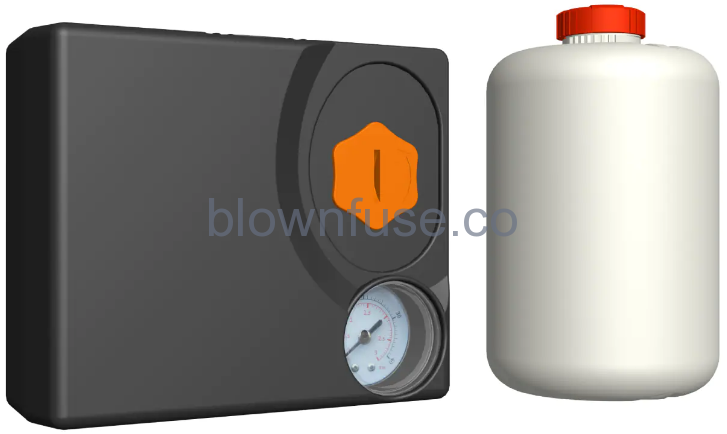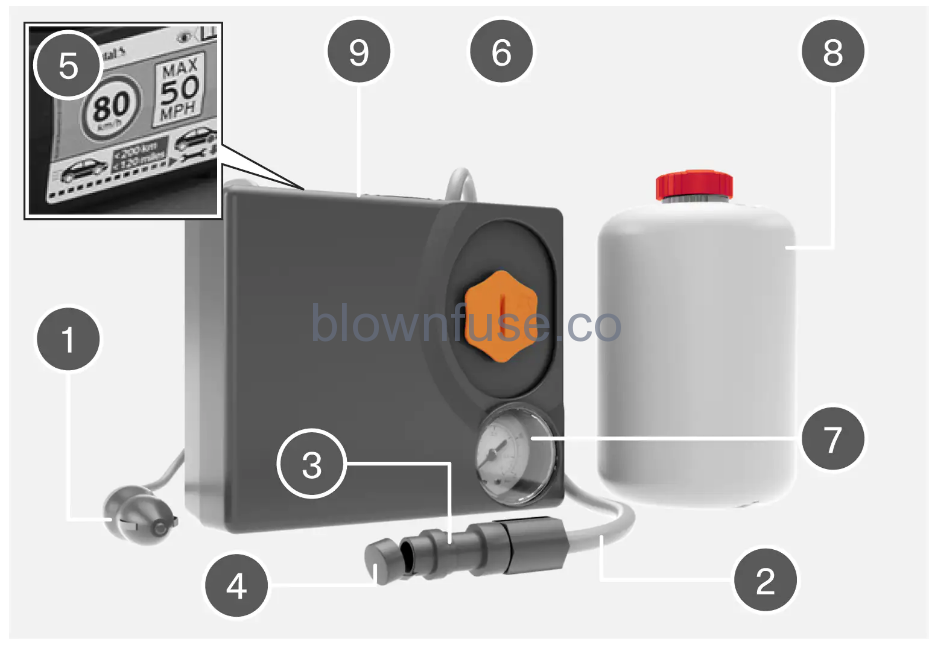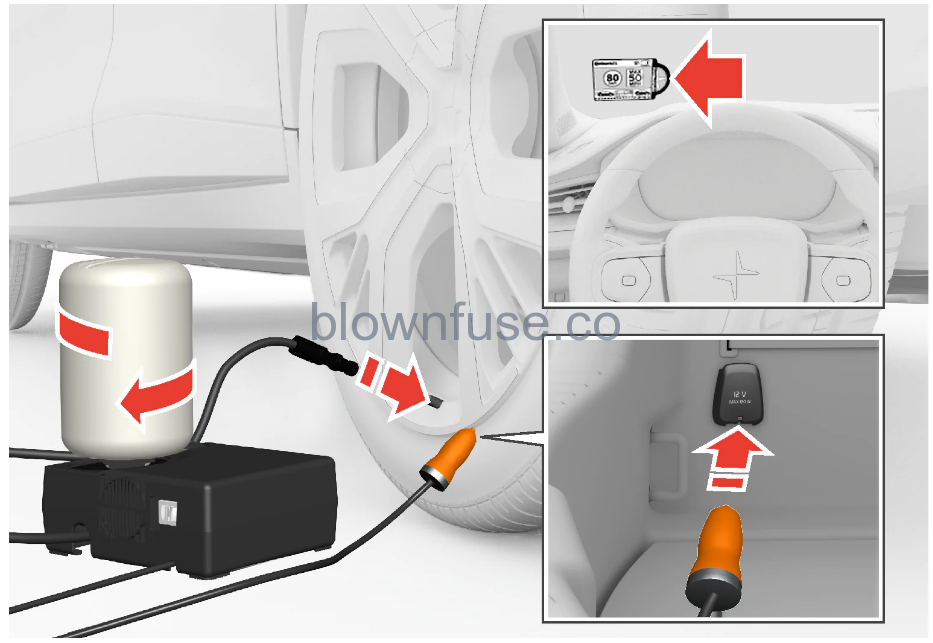2023 Polestar 2 Temporary tire sealing
Inflating tires using the tire sealing system compressor
- The compressor must be switched off. Make sure that the switch is in the 0 (Off) position and take out the electrical cable and the hose.
- Unscrew the tire’s valve cap and screw the hose’s valve connector as far as possible onto the valve.Be sure the air release valve on the compressor’s hose is completely closed.
- Plug the electrical cable into the nearest 12 V outlet and make sure that the 12 V outlet is supplying electrical current.
Never leave children unattended in the vehicle while it is running.
- Start the compressor by moving the switch to the I (On) position.
To help avoid overheating, the compressor should never be used for more than 10 minutes at a time.
- Inflate the tire to the pressure specified on the tire pressure decal on the driver’s side door pillar. If the inflation pressure is too high, use the air release valve to release air.
- Switch off the compressor. Remove the hose and the electrical cable.
- Screw the valve cap back onto the tire.
- After inflating a tire, always replace the valve cap to help prevent valve damage caused by gravel, dirt, etc.
- Only use plastic valve caps or original Polestar valve caps.
The compressor is an electric device. Follow local regulations for disposal.
Tire sealing system
California Proposition 65
Operating, servicing and maintaining a passenger vehicle can expose you to chemicals including engine exhaust, carbon monoxide, phthalates, and lead, which are known to the State of California to cause cancer and birth defects or other reproductive harm. To minimize exposure, avoid breathing exhaust, do not idle the engine except as necessary, service your vehicle in a well ventilated area and wear gloves or wash your hands frequently when servicing your vehicle. For more information go to www.P65Warnings.ca.gov/passenger-vehicle.
The tire sealing system consists of a compressor and a bottle containing sealing compound. The sealing functions as a temporary repair.
The sealing compound effectively seals tires with punctures in the tread, but it should not be used to seal tires with punctures in the sidewall. Do not use the tire sealing system on tires with large tears, cracks or similar damage.
The compressor is intended for temporary tire sealing and is approved by Polestar.
Location
The tire sealing system is stowed in the storage compartment under the hood.

Sealing compound expiration date
The sealing compound bottle must be replaced if its expiration date has passed (see the decal on the bottle). Handle the old bottle as hazardous waste.
Using the tire sealing system
Overview

- Electrical cable
- Hose
- Air release valve
- Protective hose cover
- Speed limit sticker
- Bottle holder (orange cover)
- Air pressure gauge
- Sealing compound bottle
- Switch
Connecting

Do not break the seal of the bottle before use. The seal is broken automatically when the bottle is screwed into place.
Please keep the following points in mind when using the tire sealing system:
- The sealing compound bottle (no. 8 in the illustration) contains 1) rubber latex, natural and 2) ethanediol. These substances are harmful if swallowed.
- The contents of this bottle may cause allergic skin reactions or otherwise be potentially harmful to the respiratory tract, the skin, the central nervous system, and the eyes.
Precautions:
- Keep out of reach of children.
- Do not ingest the contents.
- Avoid prolonged or repeated contact with the skin. Remove any clothing that has come into contact with sealant.
- Wash thoroughly after handling.
First aid:
- Skin: Wash affected areas of the skin with soap and water. Get medical attention if symptoms occur.
- Eyes: Flush with plenty of water for least 15 minutes, occasionally lifting the upper and lower eyelids. Get medical attention if symptoms occur.
- Inhalation: Move the exposed person to fresh air. If irritation persists, get medical attention.
- Ingestion: Do NOT induce vomiting unless directed to do so by medical personnel. Get medical attention.
- Disposal: Dispose of this material and its container at a hazardous or special waste collection point.
Do not remove the bottle or the air hose while the tire sealing system is being used.
- PreparationsTurn on the vehicle’s hazard warning flashers if the tire sealing system is to be used in an area with traffic.
If the puncture was caused by a nail or similar object, do not remove it. It will help seal the hole.
- Peel off the speed limit sticker from the side of the compressor. Affix the decal to a clearly visible location on the windshield to remind the driver not to exceed this speed limit. Do not drive faster than 80 km/h (50 mph) while using a tire that has been temporarily repaired with the tire sealing system.
- Make sure the switch is in the 0 (Off) position and take out the electric cable and the hose.
- Unscrew the orange cover on the compressor and unscrew the cap on the sealing compound bottle.
- Screw the bottle onto the bottle holder as far as possible.The bottle and the bottle holder are equipped with catches to help prevent the sealing compound from leaking. Once the bottle is screwed into place into the bottle holder, it cannot be unscrewed. Only a workshop may remove the bottle – contact Polestar Customer Support.
Do not unscrew the bottle. It is equipped with a catch to prevent leakage.
- Unscrew the tire’s valve cap and screw the hose’s valve connector as far as possible onto the valve.Be sure the air release valve on the compressor’s hose is completely closed.
- Begin tire sealingConnect the electrical cable to the nearest 12 V outlet and start the vehicle. Make sure none of the other 12 V outlets are in use while the compressor is running.
Never leave children unattended in the vehicle while it is running.
- Start the compressor by moving the switch to the I (On) position.When the compressor starts, the pressure can increase up to 6 bar (88 psi) but the pressure will drop after about 30 seconds.
Never stand next to a tire being inflated with the compressor. If cracks, bulges, etc. form on the tire, switch off the compressor immediately. The vehicle should not be driven. Call roadside assistance to have the vehicle towed to a workshop for inspection/replacement of the tire. Contact Polestar Customer Support.
- Inflate the tire for 7 minutes.
To help avoid overheating, the compressor should never be used for more than 10 minutes at a time.
- Switch off the compressor and check the inflation pressure using the air pressure gauge. The inflation pressure should be between 1.8 bar (22 psi) and 3.5 bar (51 psi). If the inflation pressure is too high, use the air release valve to release air.
If pressure falls below 1.8 bar (22 psi), the hole in the tire may be too large. The vehicle should not be driven. Call roadside assistance to have the vehicle towed to a workshop for inspection/replacement of the tire. Contact Polestar Customer Support.
- Switch off the compressor and remove the electrical cable.
- Unscrew the hose from the tire’s valve and screw the valve cap back on.
- After inflating a tire, always replace the valve cap to help prevent valve damage caused by gravel, dirt, etc.
- Only use plastic valve caps or original Polestar valve caps.
- Put the protective hose cover onto the hose to help prevent leakage of any residual sealing compound. Return the equipment to the trunk.
- Immediately drive the vehicle at least 3 km (2 miles) at a maximum speed of 80 km/h (50 mph) to allow the sealing compound to seal the tire, and then recheck the inflation pressure.
During the tire’s first revolution, some sealing compound may spray out of the puncture hole. Before driving away, make sure that no one is near the vehicle who could be sprayed with sealing compound. Make sure no one is within 2 meters(7 feet) of the vehicle.
- Rechecking the inflation pressureConnect the hose to the tire’s valve and screw the hose connector onto the valve as far as possible. The compressor must be switched off.
- Check the inflation pressure on the air pressure gauge.
- If the pressure is under 1.3 bar (19 psi), the tire is not sufficiently sealed. The vehicle should not be driven. Call roadside assistance to have the vehicle towed.
- If the inflation pressure is higher than 1.3 bar (19 psi), the tire must be inflated to the inflation pressure specified on the tire pressure decal on the driver’s side door pillar (1 bar = 100 kPa = 14.5 psi). If the inflation pressure is too high, use the air release valve to release air.
Check inflation pressure regularly.
Polestar recommends driving to the nearest workshop to have the tire replaced/repaired. Inform the workshop that the tire contains sealing compound.
The sealing compound bottle and the hose must be replaced after use – contact Polestar Customer Support.
After using the tire sealing system, the vehicle should not be driven farther than approximately 200 km (120 miles).
The compressor is an electric device. Follow local regulations for disposal.


